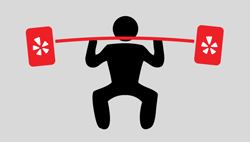I should clarify something before we get started: I’m not talking about your actual haircut, which I’m sure is stylish.
Instead, I’m talking about the experience of getting your hair cut—especially your interactions with the person who is doing the cutting.
Let me explain.
As a CMO and sales executive, I talk to people all day long. When I’m getting my hair cut, I just want to sit down, be quiet, and listen.
On the one hand, it’s a chance to relax. On the other hand, I have a lot to learn from my barber.
The man who cuts my hair is 62 years old. He’s owned three different businesses, studied electrical engineering, speaks five languages, and has been married and divorced. He has three children who, among them, are gifted cellists, flamenco dancers, and jiu jitsu experts. He was born in Colombia and grew up on a farm in Panama.
For fascinating stories, you can’t beat my barber.
But there’s more he can offer to me as a marketer and entrepreneur. For example, he makes a special effort to go out to lunch and dinner (and often drinks) with every single local business owner within a 15-block radius of his barbershop. He interacts with dozens of loyal clients every week. How could I not learn something from this guy?
My point here is that innovation thrives on diversity of thought and perspective. Ask yourself, how insular is the community that you’re a part of? When you network, are you primarily connecting with people who look like you, with similar educational and professional backgrounds? Chances are, through no fault of your own, your peers are pretty similar to you.
Fostering a good relationship with your barber or hairstylist is just one way of breaking through that wall and reaching for new perspectives. There are many more: volunteering, connecting with your local neighborhood association or civic groups, or simply being more open to conversation with the employees and patrons at your local haunts.
The idea that broadening perspectives leads to bigger thinking didn’t start with the conversations my barber and I share each month. In fact, a 2013 study profiled in the Harvard Business Review actually quantified these findings: companies with higher numbers of employees that had both cultural and gender diversity and diversity of experiences were 70% more likely to successfully enter new markets than their competitors without that higher diversity level.
As the authors noted, the strength of these companies came not only from their wide array of perspectives, but the fact that they were able to see opportunities where other companies did not. “Inherently diverse contributors understand the unmet needs in under-leveraged markets,” they wrote. “We’ve found that when at least one member of a team has traits in common with the end user, the entire team better understands that user.”
I look at my conversations with my barber this way. Sure, we have some traits in common—we’re both men, we both live and work in New York City, we both have a passion for entrepreneurship and business—but what really makes our relationship impactful is how we differ. My barber can see opportunities in market segments I haven’t even considered, partly from his background and partly from the very different mix of people who he’s exposed to everyday in his barber chairs. By listening carefully to his insights, I become a better marketer and a more attuned observer of economic trends in our shared city.
We often champion diversity in our society for very good reasons—it makes us more empathetic, it enhances our relationships, it makes our cultural life richer. But in the business world, that’s not always the case. Too often, we network with people who look and act like us, and we see business opportunities only in the markets where we feel most comfortable. But by doing so, we’re missing big opportunities for creative innovation and change.
Just ask my barber. If you’re a small business owner within 15 blocks of his shop, chances are you’ll be getting your dinner invite soon.

